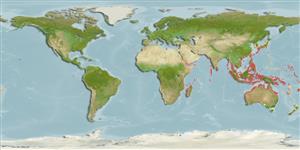>
Blenniiformes (Blennies) >
Blenniidae (Combtooth blennies) > Salariinae
Etymology: Istiblennius: Greek, istios = sail + Greek, blennios = mucus (Ref. 45335).
Eponymy: Jean-Jacques Dussumier (1792–1883) was a French merchant, collector, traveller and ship owner. [...] (Ref. 128868), visit book page.
More on author: Valenciennes.
Environment: milieu / climate zone / εύρος βάθους / distribution range
Οικολογία
Θαλασσινό(ά); Υφάλμυρο Υφαλόφιλο(α); εύρος βάθους 0 - 3 m (Ref. 86942). Tropical
Indo-West Pacific. East Africa to Fiji, north to Taiwan, south to the Norfolk Island.
Μέγεθος / Βάρος / Age
Γεννητική Ωρίμανση: Lm ? range ? - ? cm
Max length : 12.0 cm TL αρσενικό/απροσδιόριστο; (Ref. 2334)
Short description
Κλείδες προσδιορισμού | Μορφολογία | Μορφομετρία
Ραχιαίες άκανθες (συνολικά) : 12 - 14; Μαλακές ραχιαίες ακτίνες (συνολικά) : 19 - 24; Εδρικές άκανθες: 2; Μαλακές εδρικές ακτίνες: 21 - 25. Dark spot distally between 1st 2 dorsal spines; (Ref. 4404). Males with about 6 dusky bands on body; females with bands that tend to form vertical rows of dusky spots; dusky spots on dorsal and caudal fins; anal fin uniformly dusky (Ref. 4404).
Body shape (shape guide): elongated; Cross section: oval.
Facultative air-breathing (Ref. 126274); Euryhaline. Adults are often found in mangrove areas (Ref. 9962). They inhabit sheltered rocky shorelines and mangroves (Ref. 37816). Oviparous. Eggs are demersal and adhesive (Ref. 205), and are attached to the substrate via a filamentous, adhesive pad or pedestal (Ref. 94114). Larvae are planktonic, often found in shallow, coastal waters (Ref. 94114).
Life cycle and mating behavior
Γεννητική Ωρίμανση | Αναπαραγωγή | Γεννοβολία | Αβγά | Γονιμότητα | Προνύμφες
Oviparous, distinct pairing (Ref. 205).
Springer, V.G. and J.T. Williams, 1994. The Indo-West Pacific blenniid fish genus Istiblennius reappraised: a revision of Istiblennius, Blenniella, and Paralticus, new genus. Smithson. Contrib. Zool. 565:1-193. (Ref. 9962)
IUCN Red List Status (Ref. 130435: Version 2025-1)
Threat to humans
Harmless
Human uses
αλιεία: χωρίς ενδιαφέρον
Εργαλεία
Special reports
Download XML
Διαδικτυακές πηγές
Estimates based on models
Preferred temperature (Αναφ.
123201): 23.1 - 29.3, mean 28.5 °C (based on 2688 cells).
Phylogenetic diversity index (Αναφ.
82804): PD
50 = 0.5001 [Uniqueness, from 0.5 = low to 2.0 = high].
Bayesian length-weight: a=0.00776 (0.00356 - 0.01695), b=3.00 (2.81 - 3.19), in cm total length, based on LWR estimates for this (Sub)family-body shape (Ref.
93245).
Τροφικό Επίπεδο (Αναφ.
69278): 2.0 ±0.00 se; based on food items.
Ελαστικότητα (Αναφ.
120179): Υψηλό, ελάχιστος χρόνος για διπλασιασμό πληθυσμού < 15 μήνες (Preliminary K or Fecundity.).
Fishing Vulnerability (Ref.
59153): Low vulnerability (10 of 100).
🛈
Nutrients (Ref.
124155): Calcium = 153 [66, 272] mg/100g; Iron = 0.793 [0.431, 1.467] mg/100g; Protein = 18.2 [17.0, 19.4] %; Omega3 = 0.0743 [, ] g/100g; Selenium = 16.7 [7.3, 39.3] μg/100g; VitaminA = 103 [26, 392] μg/100g; Zinc = 3.01 [1.92, 4.68] mg/100g (wet weight);
